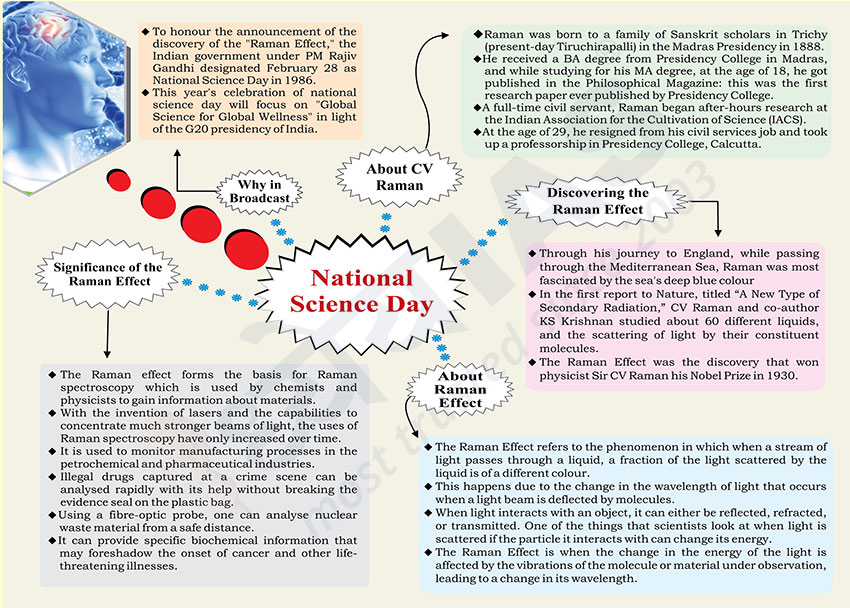Brain-booster
/
28 Mar 2023
Brain Booster for UPSC & State PCS Examination (Topic: National Science Day)

Why in Broadcast?
- To honour the announcement of the discovery of the "Raman Effect," the
Indian government under PM Rajiv Gandhi designated February 28 as National
Science Day in 1986.
- This year's celebration of national science day will focus on "Global
Science for Global Wellness" in light of the G20 presidency of India.
About CV Raman
- Raman was born to a family of Sanskrit scholars in Trichy (present-day
Tiruchirapalli) in the Madras Presidency in 1888.
- He received a BA degree from Presidency College in Madras, and while
studying for his MA degree, at the age of 18, he got published in the
Philosophical Magazine: this was the first research paper ever published by
Presidency College.
- A full-time civil servant, Raman began after-hours research at the
Indian Association for the Cultivation of Science (IACS).
- At the age of 29, he resigned from his civil services job and took up a
professorship in Presidency College, Calcutta.
Discovering the Raman Effect
- Through his journey to England, while passing through the Mediterranean
Sea, Raman was most fascinated by the sea's deep blue colour
- In the first report to Nature, titled “A New Type of Secondary
Radiation,” CV Raman and co-author KS Krishnan studied about 60 different
liquids, and the scattering of light by their constituent molecules.
- The Raman Effect was the discovery that won physicist Sir CV Raman his
Nobel Prize in 1930.
About Raman Effect
- The Raman Effect refers to the phenomenon in which when a stream of
light passes through a liquid, a fraction of the light scattered by the
liquid is of a different colour.
- This happens due to the change in the wavelength of light that occurs
when a light beam is deflected by molecules.
- When light interacts with an object, it can either be reflected,
refracted, or transmitted. One of the things that scientists look at when
light is scattered if the particle it interacts with can change its energy.
- The Raman Effect is when the change in the energy of the light is
affected by the vibrations of the molecule or material under observation,
leading to a change in its wavelength.
Significance of the Raman Effect
- The Raman effect forms the basis for Raman spectroscopy which is used by
chemists and physicists to gain information about materials.
- With the invention of lasers and the capabilities to concentrate much
stronger beams of light, the uses of Raman spectroscopy have only increased
over time.
- It is used to monitor manufacturing processes in the petrochemical and
pharmaceutical industries.
- Illegal drugs captured at a crime scene can be analysed rapidly with its
help without breaking the evidence seal on the plastic bag.
- Using a fibre-optic probe, one can analyse nuclear waste material from a
safe distance.
- It can provide specific biochemical information that may foreshadow the
onset of cancer and other lifethreatening illnesses.







